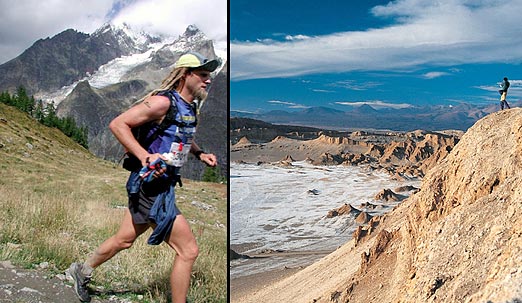The inspiration for today’s marathon and ultra-marathon comes from an ancient Greek messenger named Pheidippides. Legend has it that in 490 B.C.E. Pheidippides ran 26 miles from Marathon to Athens, delivered the news of the Greek victory, and then dropped dead. Pheidippides had earlier run 150 miles to Sparta in an unsuccessful effort to gain immediate Spartan military support for the battle of Marathon. (Why Pheidippides died after a significantly shorter run has inspired much scholarly debate.)
Long-distance running has evolved a great deal since the fifth century B.C.E. Today the sport involves everything from an easy 3K run to a 150-mile ultra-marathon. One particularly appealing aspect of competitive running is that practice is self-directed. The runner can set his or her own training schedule. Another attractive feature of the sport is that success is not measured solely by winning or losing; the late Fred Lebow, former president of New York Road Runners explained: “In running, it doesn’t matter whether you come in first, in the middle of the pack, or last. You can say, ‘I have finished.’ There is a lot of satisfaction in that.” Perhaps for this reason or just the love of free-movement, and a sense of mission accomplished, long-distance racing can be found across the globe and in a wide variety of climates and terrains.
Gear:
Pheidippides may have completed the world’s first marathon barefoot, but most modern runners rely on sneakers. Proper footwear is one of the most important pieces of gear in a long-distance runner’s world. Short distance runners want very light, slipper-like sneakers, but marathoners and ultra-marathoners need to protect themselves from the constant pounding they’ll endure along the course. Proper running shoes should be springy with plenty of cushioning on the inside and adequate arch and ankle support. Depending on the type of race, this might be anything from a standard running shoe to a lightweight hiking boot. Many runners also wear pedometers or speedometers that track miles traveled and speed. Some stage (multiple-day) ultra-marathoners must carry camping gear, so lightweight outdoor equipment is key.
Training:
To begin and, more importantly, to finish a race, a runner must pace him- or herself by adhering to pre-determined time and distance goals. Determining and pursuing these goals requires months of training. Most standard-distance and ultra-marathoners have training schedules that alternate between short (3-4 miles) and long (7-15 miles) runs. Depending on the type of race, runners may also need to incorporate terrain in their regimens, such as running up and down hills. Some competitors hire running coaches who do everything from designing training calendars to creating proper diets for their clients.
- Triathlon
Iron Man World Championship Location: Kona, Hawaii Time of Year: July Race Type: Qualifier race Race Specifics: 2,000 participants, 2.4-mile swim, 112-mile bike, 26.2-mile marathon Weather: In the 100s, with strong headwinds Terrain: Hilly
http://vnews.ironmanlive.com/
Photo: Ronen Zilberman/AP
- Trialthlon
The Escape From AlcatrazSM Triathlon Location: San Francisco, California Time of Year: June Race Type: Qualifier race Race Specifics: 48 participants, 1.5-mile swim, 18-mile bike, eight-mile run Weather: 70s-80s Terrain: Hilly with very cold water
http://www.tricalifornia.com/alcatraz/2005/
Photo: Escape from Alcatraz Triathlon
- Rocky Desert with Climbing
Kiehl's Badwater Ultramarathon Location: California (Death Valley to Mt. Whitney) Time of Year: July Race Type: Invitational Race Specifics: 135-mile run, runners can have vehicles accompany them Weather: 124-130 degrees Fahrenheit Terrain: Roadways, well-marked paths, and steep inclines
http://www.badwaterultra.com/
Photo: Chris Kostman/BadwaterUltra.com
- Rocky Desert with Climbing
South African Kalahari Augrabies Extreme Marathon Location: South Africa Time of Year: October Race Type: Seven-day stage race Race Specifics: 250-kilometer self-sufficiency run; runners must carry their own gear Weather: Up to 104 during the day, near freezing at night Terrain: Rocky and steep
http://www.extrememarathons.com
Photo: John and Terry Sadie
- Arid Desert
Atacama Crossing Location: Chile Time of Year: July Race Type: Seven-day stage race open to all applicants Race Specifics: 150-mile self-sufficiency run; runners must carry their own gear Weather: 50s-80s, very dry desert Terrain: Flat, hard dirt paths, some rocky climbs
http://www.racingtheplanet.com/atacamacrossing/
Photo: Atacama Crossing
- Arid Desert
Sahara Marathon Location: Tindouf, Algeria Time of Year: February Race Type: Single-stage race open to all applicants Race Specifics: 26.2-mile run Weather: 35-70 degrees Fahrenheit, sandstorms, and very dry desert Terrain: Mostly flat, dry sand
http://www.saharamarathon.org/
Photo: Aiala Fernández
- Mountainous
Vermont 100 Location: Vermont Time of Year: July Race Type: Single-stage race open to all applicants Race Specifics: 100-mile run, 30-hour time limit Weather: 80s Terrain: Wooded paths, some rocky trails, very hilly
http://www.vermont100.com
Photo: Vermont 100
- Mountainous
The North Face Ultra-Trail du Tour du Mont Blanc Location: France Time of Year: August Race Type: Single-stage race open to all applicants Race Specifics: 150-kilometer run crossing three countries Weather: 60s Terrain: Rocky and steep with a total elevation increase of 8,500 meters
http://www.ultratrailmb.com/accueil.php
Photo: North Face Ultra-Trail
- World Heritage Sites
Great Wall Marathon Location: China Time of Year: May Race Type: Single-stage race open to all applicants Race Specifics: 26.2-mile run Weather: Windy, in the 70s Terrain: Village streets and the 3,700 steps of the Great Wall of China
http://www.great-wall-marathon.com
Photo: Corel
- World Heritage Sites
Jungle Marathon Location: Amazon Jungle, Brazil Time of Year: September Race Type: Six-stage self-sufficiency race (runners must carry their own gear) open to all applicants Race Specifics: 125-mile run Weather: 80s with extreme humidity Terrain: Jungle paths, rocky trails, river and stream crossings
http://www.dreamchaserevents.com/ JungleMarathon/index-jungle.htm
Photo: Armin Schirmaier














